MGT3SMG Research Portfolio: Strategic Analysis of the Thales Group
VerifiedAdded on 2023/06/12
|12
|3000
|280
Report
AI Summary
This research portfolio delves into the Thales Group, a French multinational company operating across aerospace, defense, security, and transport sectors. It examines the company's origins from the merger of Thomson Brandt Company and CSF, its global presence in 56 countries, and its strategic focus on innovative solutions. A PESTEL analysis assesses the political, economic, social, technological, environmental, and legal factors influencing Thales' operations, highlighting opportunities and threats. The report identifies Boeing and Lockheed Martin as key competitors, employing Porter's Five Forces to analyze their competitive positions. Furthermore, it explores the business-level strategies of Thales' protected vehicles division in Bendigo, Australia, and its cybersecurity division, emphasizing the importance of innovation and talent acquisition. This portfolio provides a comprehensive overview of Thales Group's strategic landscape, competitive dynamics, and operational approaches.
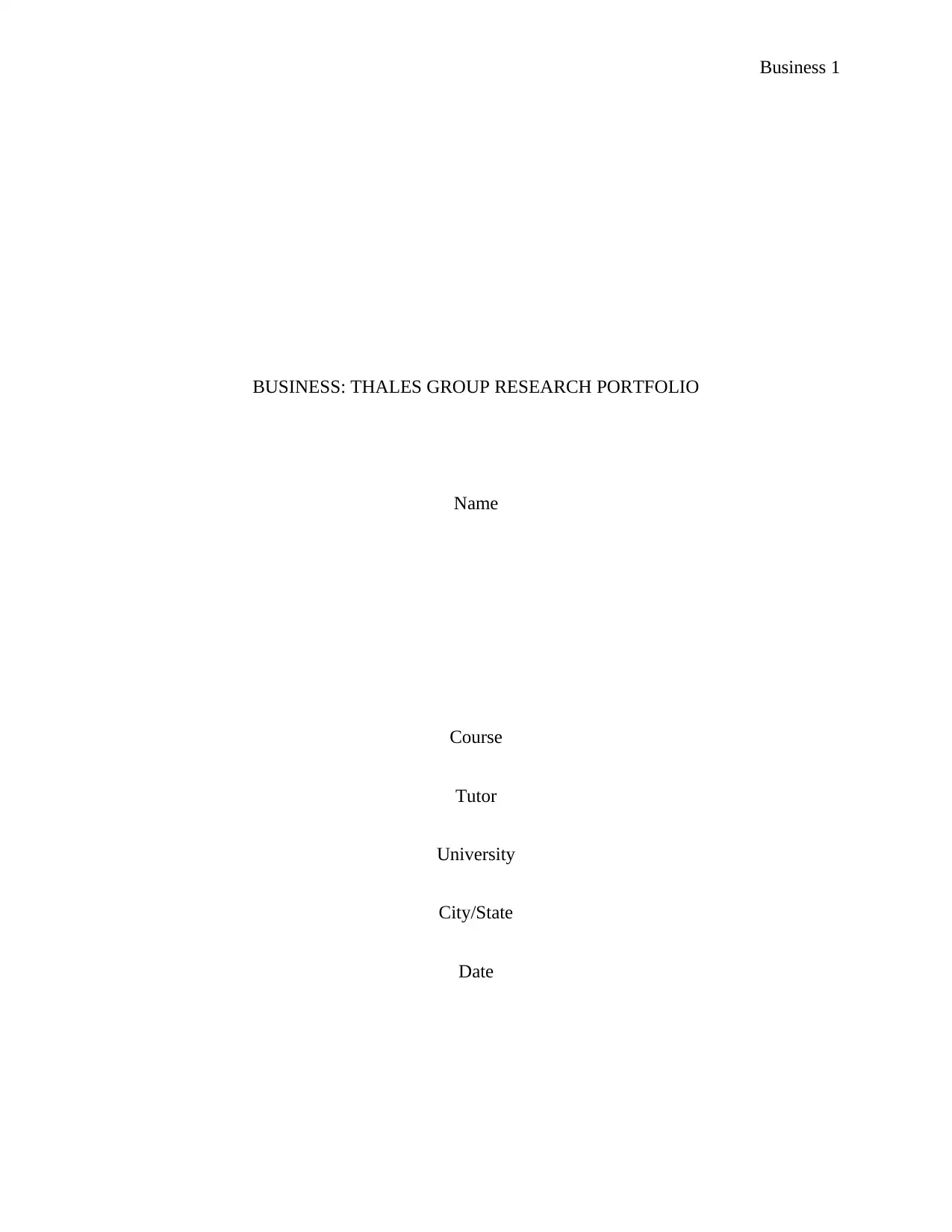
Business 1
BUSINESS: THALES GROUP RESEARCH PORTFOLIO
Name
Course
Tutor
University
City/State
Date
BUSINESS: THALES GROUP RESEARCH PORTFOLIO
Name
Course
Tutor
University
City/State
Date
Paraphrase This Document
Need a fresh take? Get an instant paraphrase of this document with our AI Paraphraser
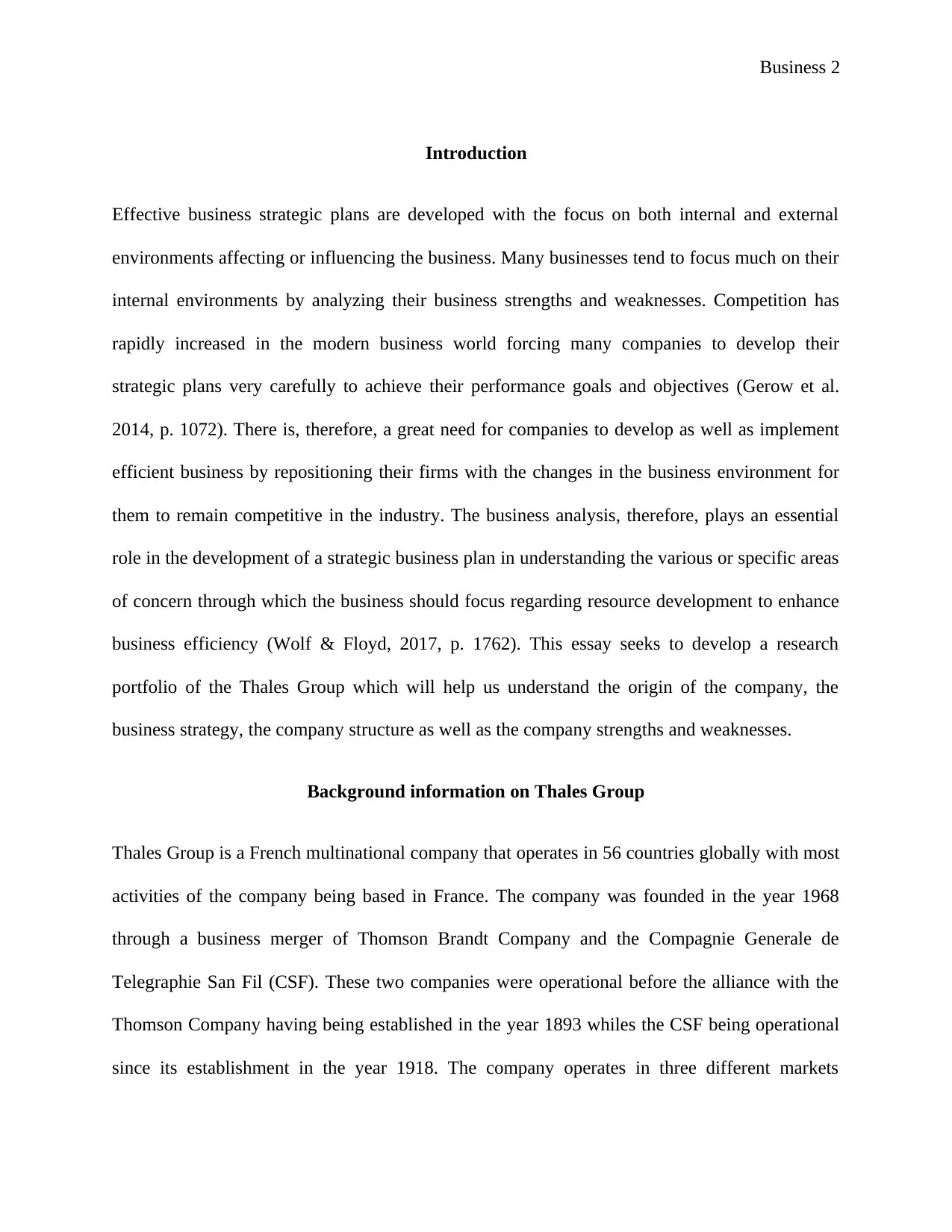
Business 2
Introduction
Effective business strategic plans are developed with the focus on both internal and external
environments affecting or influencing the business. Many businesses tend to focus much on their
internal environments by analyzing their business strengths and weaknesses. Competition has
rapidly increased in the modern business world forcing many companies to develop their
strategic plans very carefully to achieve their performance goals and objectives (Gerow et al.
2014, p. 1072). There is, therefore, a great need for companies to develop as well as implement
efficient business by repositioning their firms with the changes in the business environment for
them to remain competitive in the industry. The business analysis, therefore, plays an essential
role in the development of a strategic business plan in understanding the various or specific areas
of concern through which the business should focus regarding resource development to enhance
business efficiency (Wolf & Floyd, 2017, p. 1762). This essay seeks to develop a research
portfolio of the Thales Group which will help us understand the origin of the company, the
business strategy, the company structure as well as the company strengths and weaknesses.
Background information on Thales Group
Thales Group is a French multinational company that operates in 56 countries globally with most
activities of the company being based in France. The company was founded in the year 1968
through a business merger of Thomson Brandt Company and the Compagnie Generale de
Telegraphie San Fil (CSF). These two companies were operational before the alliance with the
Thomson Company having being established in the year 1893 whiles the CSF being operational
since its establishment in the year 1918. The company operates in three different markets
Introduction
Effective business strategic plans are developed with the focus on both internal and external
environments affecting or influencing the business. Many businesses tend to focus much on their
internal environments by analyzing their business strengths and weaknesses. Competition has
rapidly increased in the modern business world forcing many companies to develop their
strategic plans very carefully to achieve their performance goals and objectives (Gerow et al.
2014, p. 1072). There is, therefore, a great need for companies to develop as well as implement
efficient business by repositioning their firms with the changes in the business environment for
them to remain competitive in the industry. The business analysis, therefore, plays an essential
role in the development of a strategic business plan in understanding the various or specific areas
of concern through which the business should focus regarding resource development to enhance
business efficiency (Wolf & Floyd, 2017, p. 1762). This essay seeks to develop a research
portfolio of the Thales Group which will help us understand the origin of the company, the
business strategy, the company structure as well as the company strengths and weaknesses.
Background information on Thales Group
Thales Group is a French multinational company that operates in 56 countries globally with most
activities of the company being based in France. The company was founded in the year 1968
through a business merger of Thomson Brandt Company and the Compagnie Generale de
Telegraphie San Fil (CSF). These two companies were operational before the alliance with the
Thomson Company having being established in the year 1893 whiles the CSF being operational
since its establishment in the year 1918. The company operates in three different markets
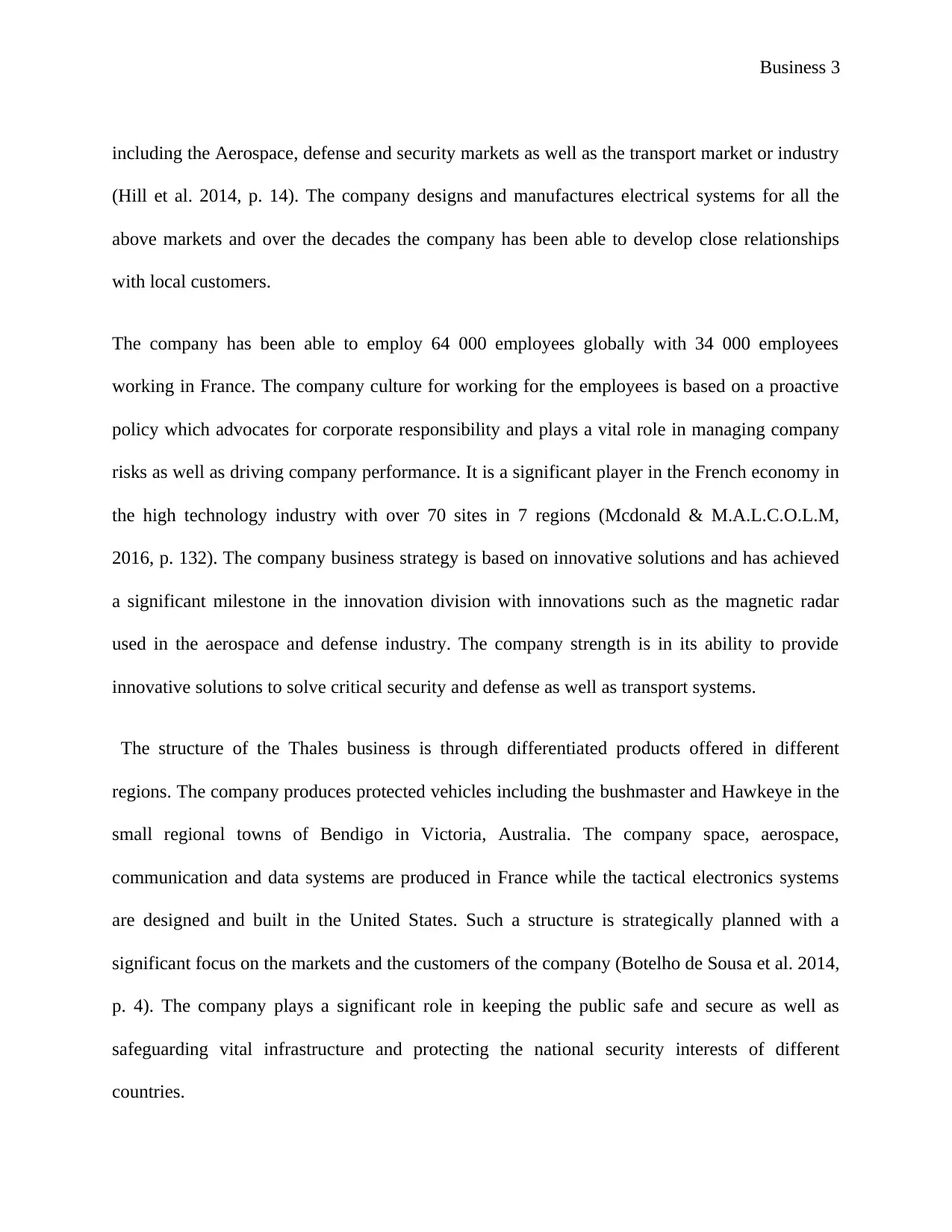
Business 3
including the Aerospace, defense and security markets as well as the transport market or industry
(Hill et al. 2014, p. 14). The company designs and manufactures electrical systems for all the
above markets and over the decades the company has been able to develop close relationships
with local customers.
The company has been able to employ 64 000 employees globally with 34 000 employees
working in France. The company culture for working for the employees is based on a proactive
policy which advocates for corporate responsibility and plays a vital role in managing company
risks as well as driving company performance. It is a significant player in the French economy in
the high technology industry with over 70 sites in 7 regions (Mcdonald & M.A.L.C.O.L.M,
2016, p. 132). The company business strategy is based on innovative solutions and has achieved
a significant milestone in the innovation division with innovations such as the magnetic radar
used in the aerospace and defense industry. The company strength is in its ability to provide
innovative solutions to solve critical security and defense as well as transport systems.
The structure of the Thales business is through differentiated products offered in different
regions. The company produces protected vehicles including the bushmaster and Hawkeye in the
small regional towns of Bendigo in Victoria, Australia. The company space, aerospace,
communication and data systems are produced in France while the tactical electronics systems
are designed and built in the United States. Such a structure is strategically planned with a
significant focus on the markets and the customers of the company (Botelho de Sousa et al. 2014,
p. 4). The company plays a significant role in keeping the public safe and secure as well as
safeguarding vital infrastructure and protecting the national security interests of different
countries.
including the Aerospace, defense and security markets as well as the transport market or industry
(Hill et al. 2014, p. 14). The company designs and manufactures electrical systems for all the
above markets and over the decades the company has been able to develop close relationships
with local customers.
The company has been able to employ 64 000 employees globally with 34 000 employees
working in France. The company culture for working for the employees is based on a proactive
policy which advocates for corporate responsibility and plays a vital role in managing company
risks as well as driving company performance. It is a significant player in the French economy in
the high technology industry with over 70 sites in 7 regions (Mcdonald & M.A.L.C.O.L.M,
2016, p. 132). The company business strategy is based on innovative solutions and has achieved
a significant milestone in the innovation division with innovations such as the magnetic radar
used in the aerospace and defense industry. The company strength is in its ability to provide
innovative solutions to solve critical security and defense as well as transport systems.
The structure of the Thales business is through differentiated products offered in different
regions. The company produces protected vehicles including the bushmaster and Hawkeye in the
small regional towns of Bendigo in Victoria, Australia. The company space, aerospace,
communication and data systems are produced in France while the tactical electronics systems
are designed and built in the United States. Such a structure is strategically planned with a
significant focus on the markets and the customers of the company (Botelho de Sousa et al. 2014,
p. 4). The company plays a significant role in keeping the public safe and secure as well as
safeguarding vital infrastructure and protecting the national security interests of different
countries.
⊘ This is a preview!⊘
Do you want full access?
Subscribe today to unlock all pages.

Trusted by 1+ million students worldwide
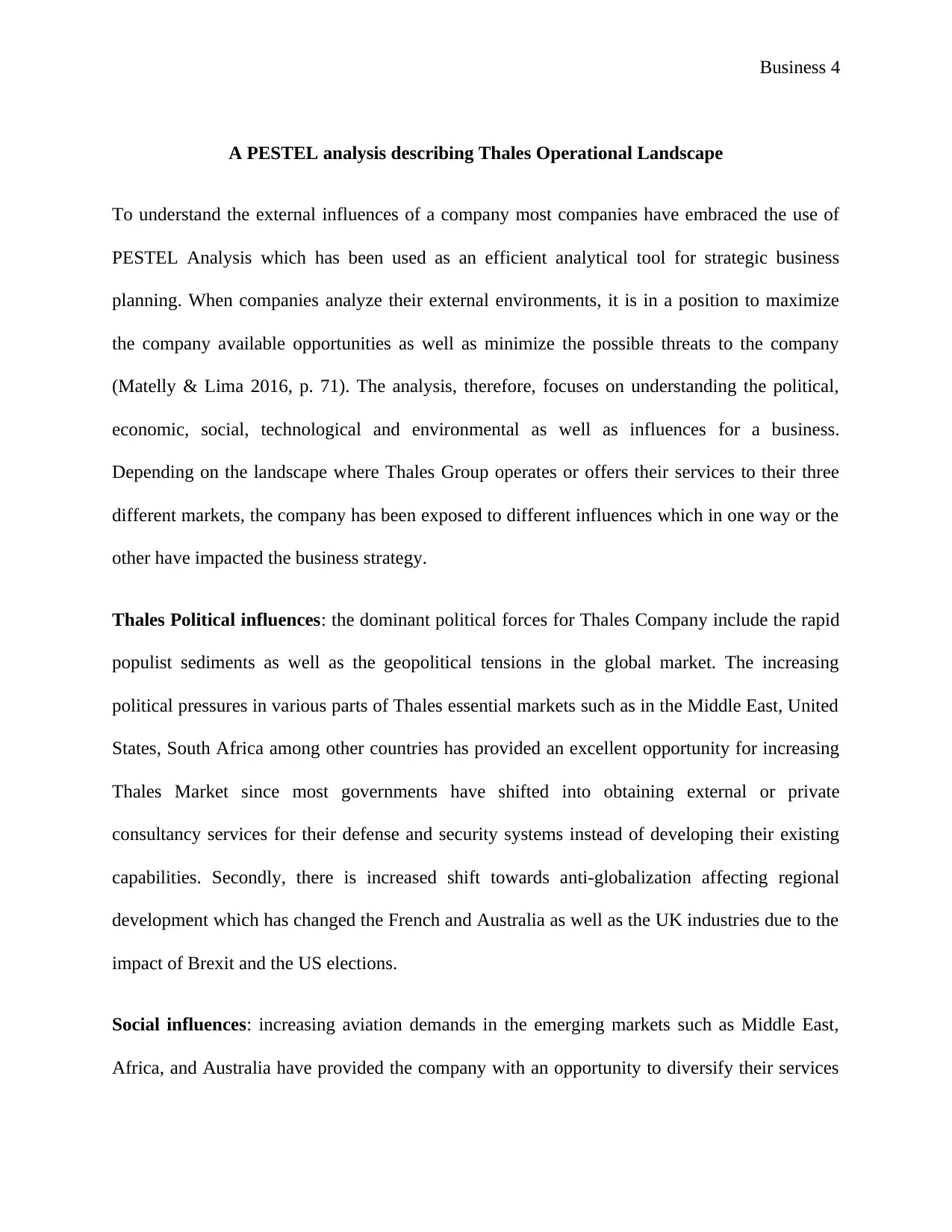
Business 4
A PESTEL analysis describing Thales Operational Landscape
To understand the external influences of a company most companies have embraced the use of
PESTEL Analysis which has been used as an efficient analytical tool for strategic business
planning. When companies analyze their external environments, it is in a position to maximize
the company available opportunities as well as minimize the possible threats to the company
(Matelly & Lima 2016, p. 71). The analysis, therefore, focuses on understanding the political,
economic, social, technological and environmental as well as influences for a business.
Depending on the landscape where Thales Group operates or offers their services to their three
different markets, the company has been exposed to different influences which in one way or the
other have impacted the business strategy.
Thales Political influences: the dominant political forces for Thales Company include the rapid
populist sediments as well as the geopolitical tensions in the global market. The increasing
political pressures in various parts of Thales essential markets such as in the Middle East, United
States, South Africa among other countries has provided an excellent opportunity for increasing
Thales Market since most governments have shifted into obtaining external or private
consultancy services for their defense and security systems instead of developing their existing
capabilities. Secondly, there is increased shift towards anti-globalization affecting regional
development which has changed the French and Australia as well as the UK industries due to the
impact of Brexit and the US elections.
Social influences: increasing aviation demands in the emerging markets such as Middle East,
Africa, and Australia have provided the company with an opportunity to diversify their services
A PESTEL analysis describing Thales Operational Landscape
To understand the external influences of a company most companies have embraced the use of
PESTEL Analysis which has been used as an efficient analytical tool for strategic business
planning. When companies analyze their external environments, it is in a position to maximize
the company available opportunities as well as minimize the possible threats to the company
(Matelly & Lima 2016, p. 71). The analysis, therefore, focuses on understanding the political,
economic, social, technological and environmental as well as influences for a business.
Depending on the landscape where Thales Group operates or offers their services to their three
different markets, the company has been exposed to different influences which in one way or the
other have impacted the business strategy.
Thales Political influences: the dominant political forces for Thales Company include the rapid
populist sediments as well as the geopolitical tensions in the global market. The increasing
political pressures in various parts of Thales essential markets such as in the Middle East, United
States, South Africa among other countries has provided an excellent opportunity for increasing
Thales Market since most governments have shifted into obtaining external or private
consultancy services for their defense and security systems instead of developing their existing
capabilities. Secondly, there is increased shift towards anti-globalization affecting regional
development which has changed the French and Australia as well as the UK industries due to the
impact of Brexit and the US elections.
Social influences: increasing aviation demands in the emerging markets such as Middle East,
Africa, and Australia have provided the company with an opportunity to diversify their services
Paraphrase This Document
Need a fresh take? Get an instant paraphrase of this document with our AI Paraphraser
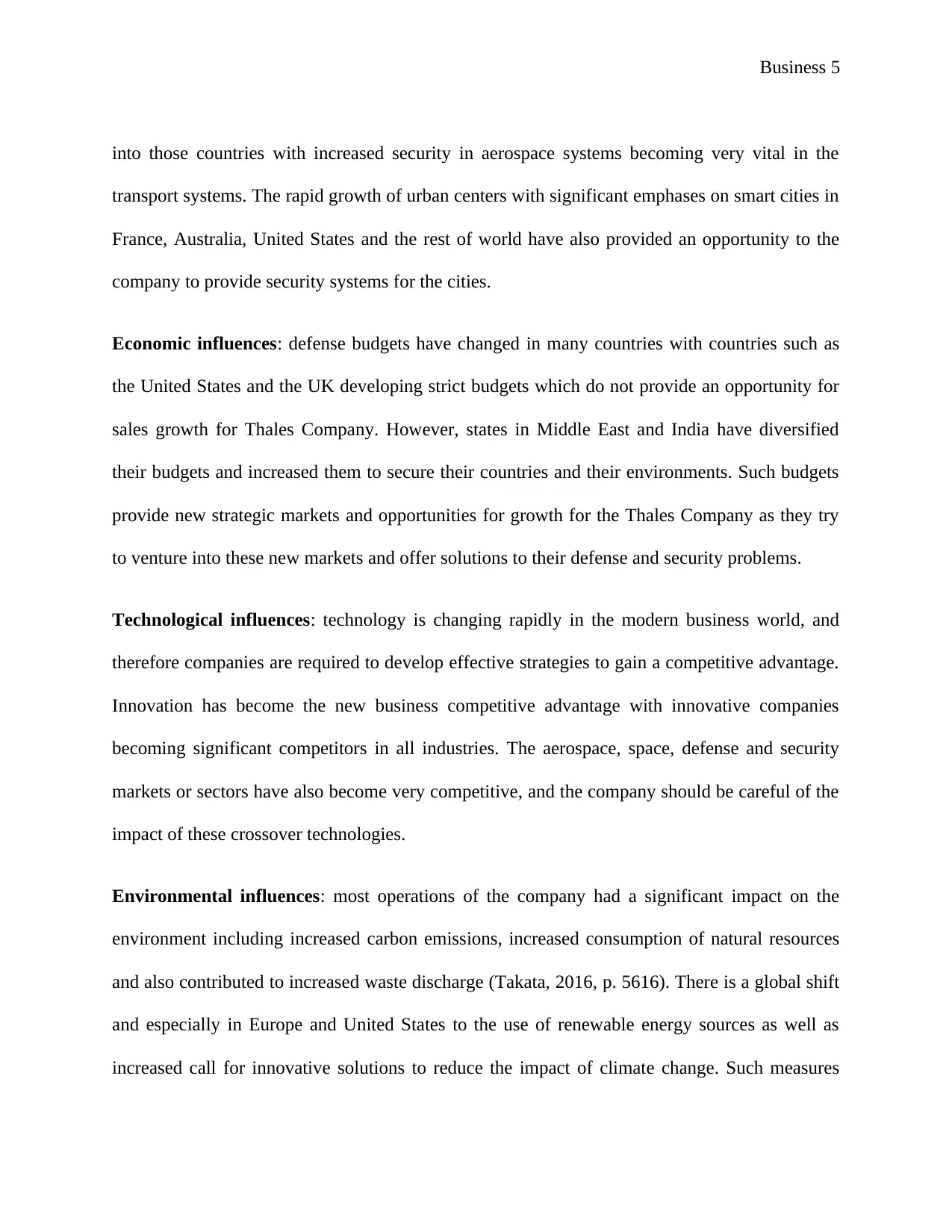
Business 5
into those countries with increased security in aerospace systems becoming very vital in the
transport systems. The rapid growth of urban centers with significant emphases on smart cities in
France, Australia, United States and the rest of world have also provided an opportunity to the
company to provide security systems for the cities.
Economic influences: defense budgets have changed in many countries with countries such as
the United States and the UK developing strict budgets which do not provide an opportunity for
sales growth for Thales Company. However, states in Middle East and India have diversified
their budgets and increased them to secure their countries and their environments. Such budgets
provide new strategic markets and opportunities for growth for the Thales Company as they try
to venture into these new markets and offer solutions to their defense and security problems.
Technological influences: technology is changing rapidly in the modern business world, and
therefore companies are required to develop effective strategies to gain a competitive advantage.
Innovation has become the new business competitive advantage with innovative companies
becoming significant competitors in all industries. The aerospace, space, defense and security
markets or sectors have also become very competitive, and the company should be careful of the
impact of these crossover technologies.
Environmental influences: most operations of the company had a significant impact on the
environment including increased carbon emissions, increased consumption of natural resources
and also contributed to increased waste discharge (Takata, 2016, p. 5616). There is a global shift
and especially in Europe and United States to the use of renewable energy sources as well as
increased call for innovative solutions to reduce the impact of climate change. Such measures
into those countries with increased security in aerospace systems becoming very vital in the
transport systems. The rapid growth of urban centers with significant emphases on smart cities in
France, Australia, United States and the rest of world have also provided an opportunity to the
company to provide security systems for the cities.
Economic influences: defense budgets have changed in many countries with countries such as
the United States and the UK developing strict budgets which do not provide an opportunity for
sales growth for Thales Company. However, states in Middle East and India have diversified
their budgets and increased them to secure their countries and their environments. Such budgets
provide new strategic markets and opportunities for growth for the Thales Company as they try
to venture into these new markets and offer solutions to their defense and security problems.
Technological influences: technology is changing rapidly in the modern business world, and
therefore companies are required to develop effective strategies to gain a competitive advantage.
Innovation has become the new business competitive advantage with innovative companies
becoming significant competitors in all industries. The aerospace, space, defense and security
markets or sectors have also become very competitive, and the company should be careful of the
impact of these crossover technologies.
Environmental influences: most operations of the company had a significant impact on the
environment including increased carbon emissions, increased consumption of natural resources
and also contributed to increased waste discharge (Takata, 2016, p. 5616). There is a global shift
and especially in Europe and United States to the use of renewable energy sources as well as
increased call for innovative solutions to reduce the impact of climate change. Such measures
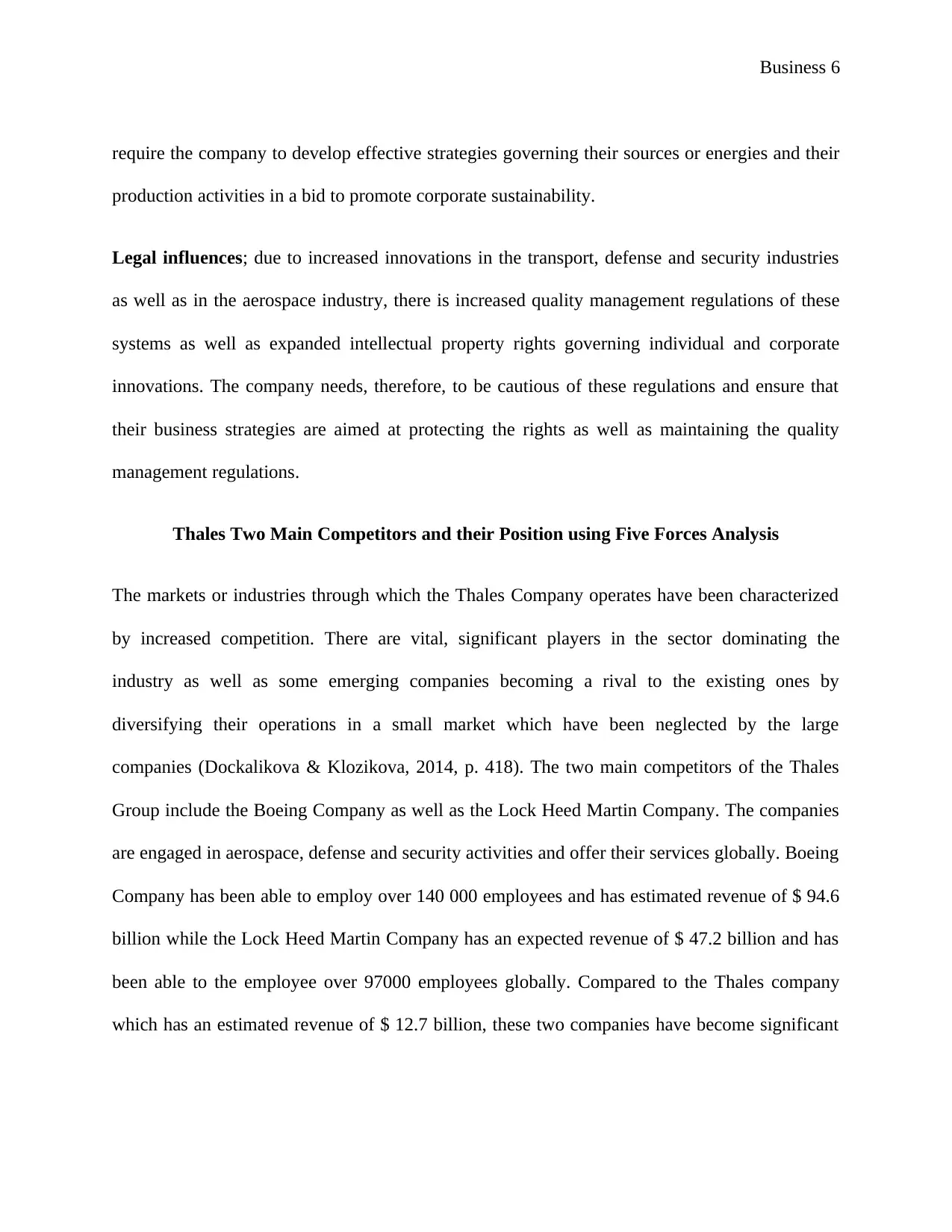
Business 6
require the company to develop effective strategies governing their sources or energies and their
production activities in a bid to promote corporate sustainability.
Legal influences; due to increased innovations in the transport, defense and security industries
as well as in the aerospace industry, there is increased quality management regulations of these
systems as well as expanded intellectual property rights governing individual and corporate
innovations. The company needs, therefore, to be cautious of these regulations and ensure that
their business strategies are aimed at protecting the rights as well as maintaining the quality
management regulations.
Thales Two Main Competitors and their Position using Five Forces Analysis
The markets or industries through which the Thales Company operates have been characterized
by increased competition. There are vital, significant players in the sector dominating the
industry as well as some emerging companies becoming a rival to the existing ones by
diversifying their operations in a small market which have been neglected by the large
companies (Dockalikova & Klozikova, 2014, p. 418). The two main competitors of the Thales
Group include the Boeing Company as well as the Lock Heed Martin Company. The companies
are engaged in aerospace, defense and security activities and offer their services globally. Boeing
Company has been able to employ over 140 000 employees and has estimated revenue of $ 94.6
billion while the Lock Heed Martin Company has an expected revenue of $ 47.2 billion and has
been able to the employee over 97000 employees globally. Compared to the Thales company
which has an estimated revenue of $ 12.7 billion, these two companies have become significant
require the company to develop effective strategies governing their sources or energies and their
production activities in a bid to promote corporate sustainability.
Legal influences; due to increased innovations in the transport, defense and security industries
as well as in the aerospace industry, there is increased quality management regulations of these
systems as well as expanded intellectual property rights governing individual and corporate
innovations. The company needs, therefore, to be cautious of these regulations and ensure that
their business strategies are aimed at protecting the rights as well as maintaining the quality
management regulations.
Thales Two Main Competitors and their Position using Five Forces Analysis
The markets or industries through which the Thales Company operates have been characterized
by increased competition. There are vital, significant players in the sector dominating the
industry as well as some emerging companies becoming a rival to the existing ones by
diversifying their operations in a small market which have been neglected by the large
companies (Dockalikova & Klozikova, 2014, p. 418). The two main competitors of the Thales
Group include the Boeing Company as well as the Lock Heed Martin Company. The companies
are engaged in aerospace, defense and security activities and offer their services globally. Boeing
Company has been able to employ over 140 000 employees and has estimated revenue of $ 94.6
billion while the Lock Heed Martin Company has an expected revenue of $ 47.2 billion and has
been able to the employee over 97000 employees globally. Compared to the Thales company
which has an estimated revenue of $ 12.7 billion, these two companies have become significant
⊘ This is a preview!⊘
Do you want full access?
Subscribe today to unlock all pages.

Trusted by 1+ million students worldwide
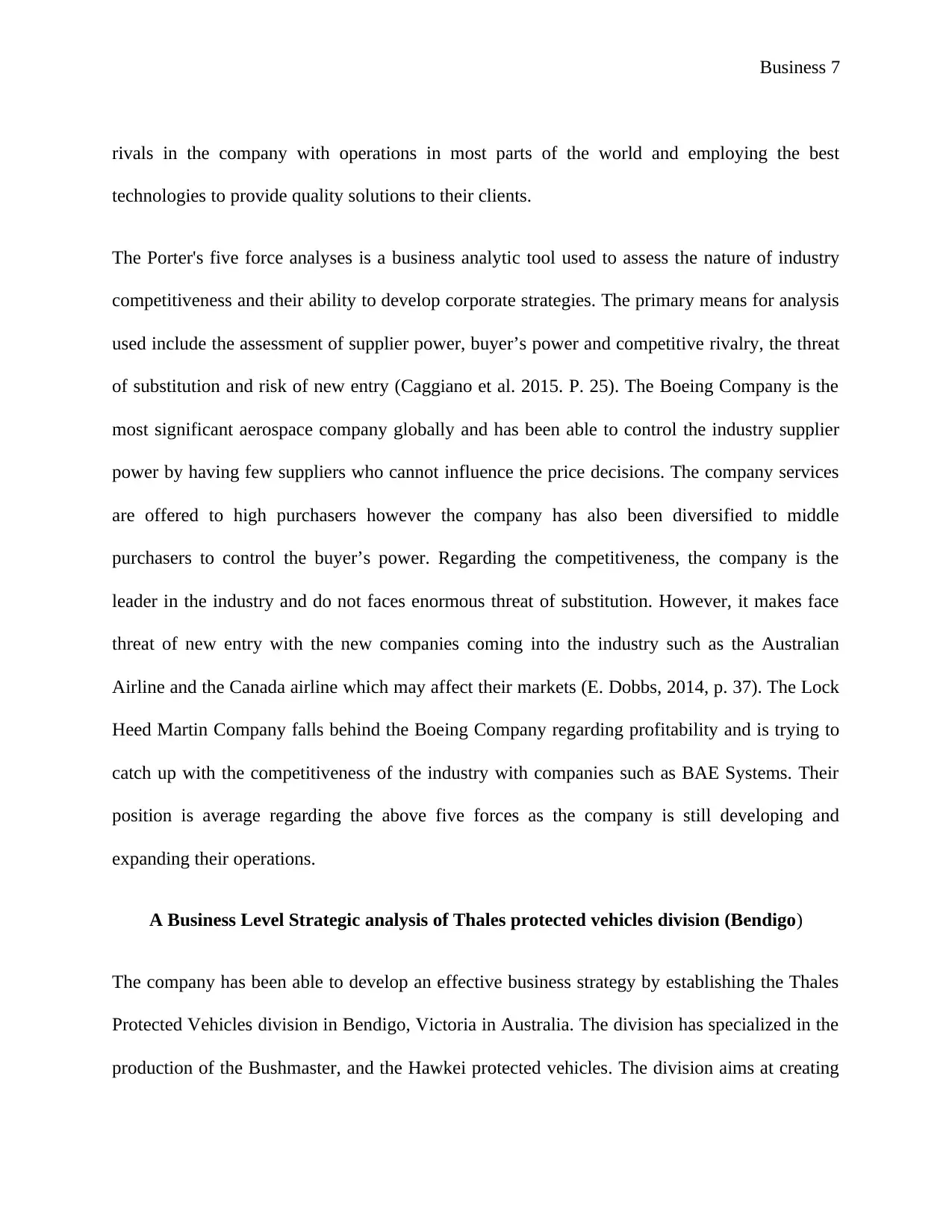
Business 7
rivals in the company with operations in most parts of the world and employing the best
technologies to provide quality solutions to their clients.
The Porter's five force analyses is a business analytic tool used to assess the nature of industry
competitiveness and their ability to develop corporate strategies. The primary means for analysis
used include the assessment of supplier power, buyer’s power and competitive rivalry, the threat
of substitution and risk of new entry (Caggiano et al. 2015. P. 25). The Boeing Company is the
most significant aerospace company globally and has been able to control the industry supplier
power by having few suppliers who cannot influence the price decisions. The company services
are offered to high purchasers however the company has also been diversified to middle
purchasers to control the buyer’s power. Regarding the competitiveness, the company is the
leader in the industry and do not faces enormous threat of substitution. However, it makes face
threat of new entry with the new companies coming into the industry such as the Australian
Airline and the Canada airline which may affect their markets (E. Dobbs, 2014, p. 37). The Lock
Heed Martin Company falls behind the Boeing Company regarding profitability and is trying to
catch up with the competitiveness of the industry with companies such as BAE Systems. Their
position is average regarding the above five forces as the company is still developing and
expanding their operations.
A Business Level Strategic analysis of Thales protected vehicles division (Bendigo)
The company has been able to develop an effective business strategy by establishing the Thales
Protected Vehicles division in Bendigo, Victoria in Australia. The division has specialized in the
production of the Bushmaster, and the Hawkei protected vehicles. The division aims at creating
rivals in the company with operations in most parts of the world and employing the best
technologies to provide quality solutions to their clients.
The Porter's five force analyses is a business analytic tool used to assess the nature of industry
competitiveness and their ability to develop corporate strategies. The primary means for analysis
used include the assessment of supplier power, buyer’s power and competitive rivalry, the threat
of substitution and risk of new entry (Caggiano et al. 2015. P. 25). The Boeing Company is the
most significant aerospace company globally and has been able to control the industry supplier
power by having few suppliers who cannot influence the price decisions. The company services
are offered to high purchasers however the company has also been diversified to middle
purchasers to control the buyer’s power. Regarding the competitiveness, the company is the
leader in the industry and do not faces enormous threat of substitution. However, it makes face
threat of new entry with the new companies coming into the industry such as the Australian
Airline and the Canada airline which may affect their markets (E. Dobbs, 2014, p. 37). The Lock
Heed Martin Company falls behind the Boeing Company regarding profitability and is trying to
catch up with the competitiveness of the industry with companies such as BAE Systems. Their
position is average regarding the above five forces as the company is still developing and
expanding their operations.
A Business Level Strategic analysis of Thales protected vehicles division (Bendigo)
The company has been able to develop an effective business strategy by establishing the Thales
Protected Vehicles division in Bendigo, Victoria in Australia. The division has specialized in the
production of the Bushmaster, and the Hawkei protected vehicles. The division aims at creating
Paraphrase This Document
Need a fresh take? Get an instant paraphrase of this document with our AI Paraphraser
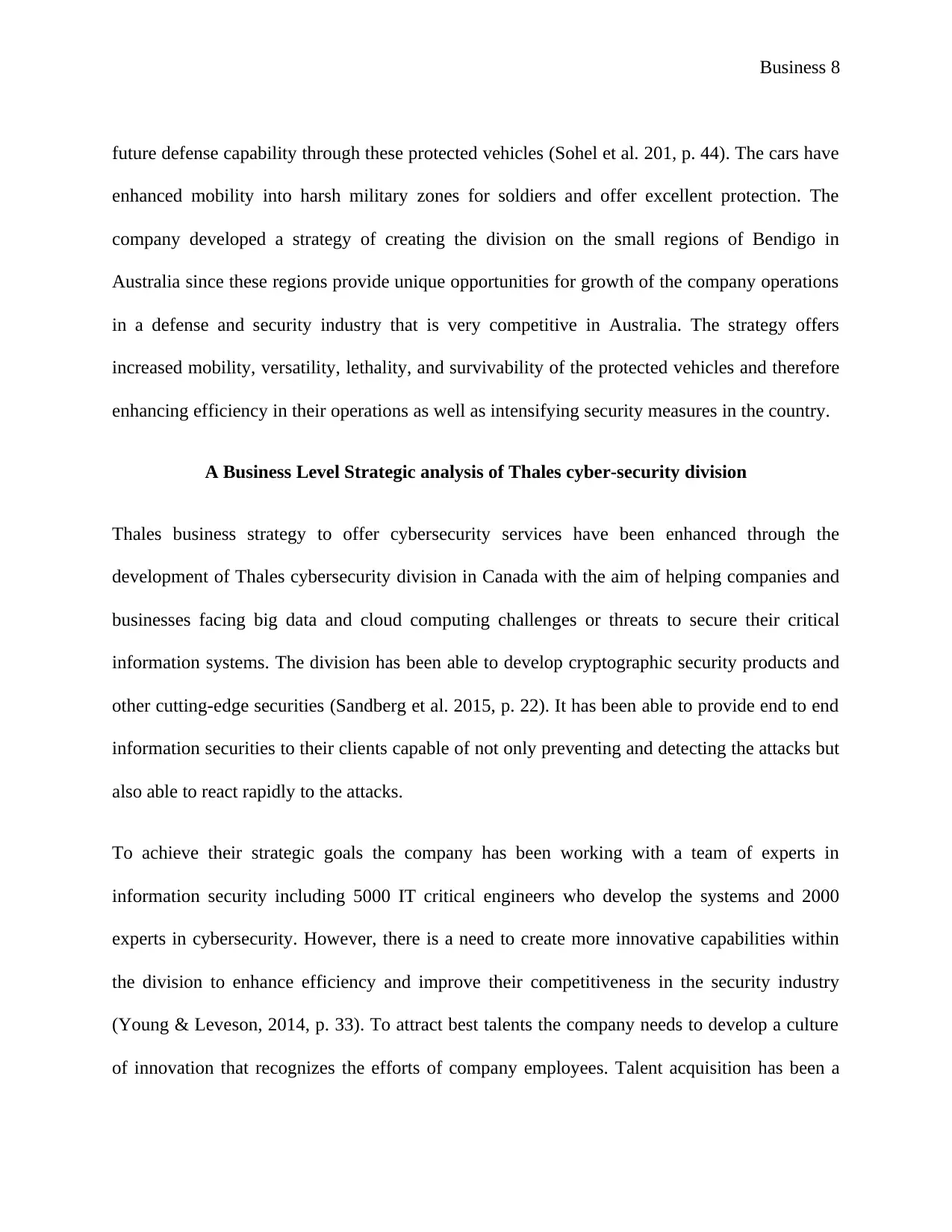
Business 8
future defense capability through these protected vehicles (Sohel et al. 201, p. 44). The cars have
enhanced mobility into harsh military zones for soldiers and offer excellent protection. The
company developed a strategy of creating the division on the small regions of Bendigo in
Australia since these regions provide unique opportunities for growth of the company operations
in a defense and security industry that is very competitive in Australia. The strategy offers
increased mobility, versatility, lethality, and survivability of the protected vehicles and therefore
enhancing efficiency in their operations as well as intensifying security measures in the country.
A Business Level Strategic analysis of Thales cyber-security division
Thales business strategy to offer cybersecurity services have been enhanced through the
development of Thales cybersecurity division in Canada with the aim of helping companies and
businesses facing big data and cloud computing challenges or threats to secure their critical
information systems. The division has been able to develop cryptographic security products and
other cutting-edge securities (Sandberg et al. 2015, p. 22). It has been able to provide end to end
information securities to their clients capable of not only preventing and detecting the attacks but
also able to react rapidly to the attacks.
To achieve their strategic goals the company has been working with a team of experts in
information security including 5000 IT critical engineers who develop the systems and 2000
experts in cybersecurity. However, there is a need to create more innovative capabilities within
the division to enhance efficiency and improve their competitiveness in the security industry
(Young & Leveson, 2014, p. 33). To attract best talents the company needs to develop a culture
of innovation that recognizes the efforts of company employees. Talent acquisition has been a
future defense capability through these protected vehicles (Sohel et al. 201, p. 44). The cars have
enhanced mobility into harsh military zones for soldiers and offer excellent protection. The
company developed a strategy of creating the division on the small regions of Bendigo in
Australia since these regions provide unique opportunities for growth of the company operations
in a defense and security industry that is very competitive in Australia. The strategy offers
increased mobility, versatility, lethality, and survivability of the protected vehicles and therefore
enhancing efficiency in their operations as well as intensifying security measures in the country.
A Business Level Strategic analysis of Thales cyber-security division
Thales business strategy to offer cybersecurity services have been enhanced through the
development of Thales cybersecurity division in Canada with the aim of helping companies and
businesses facing big data and cloud computing challenges or threats to secure their critical
information systems. The division has been able to develop cryptographic security products and
other cutting-edge securities (Sandberg et al. 2015, p. 22). It has been able to provide end to end
information securities to their clients capable of not only preventing and detecting the attacks but
also able to react rapidly to the attacks.
To achieve their strategic goals the company has been working with a team of experts in
information security including 5000 IT critical engineers who develop the systems and 2000
experts in cybersecurity. However, there is a need to create more innovative capabilities within
the division to enhance efficiency and improve their competitiveness in the security industry
(Young & Leveson, 2014, p. 33). To attract best talents the company needs to develop a culture
of innovation that recognizes the efforts of company employees. Talent acquisition has been a
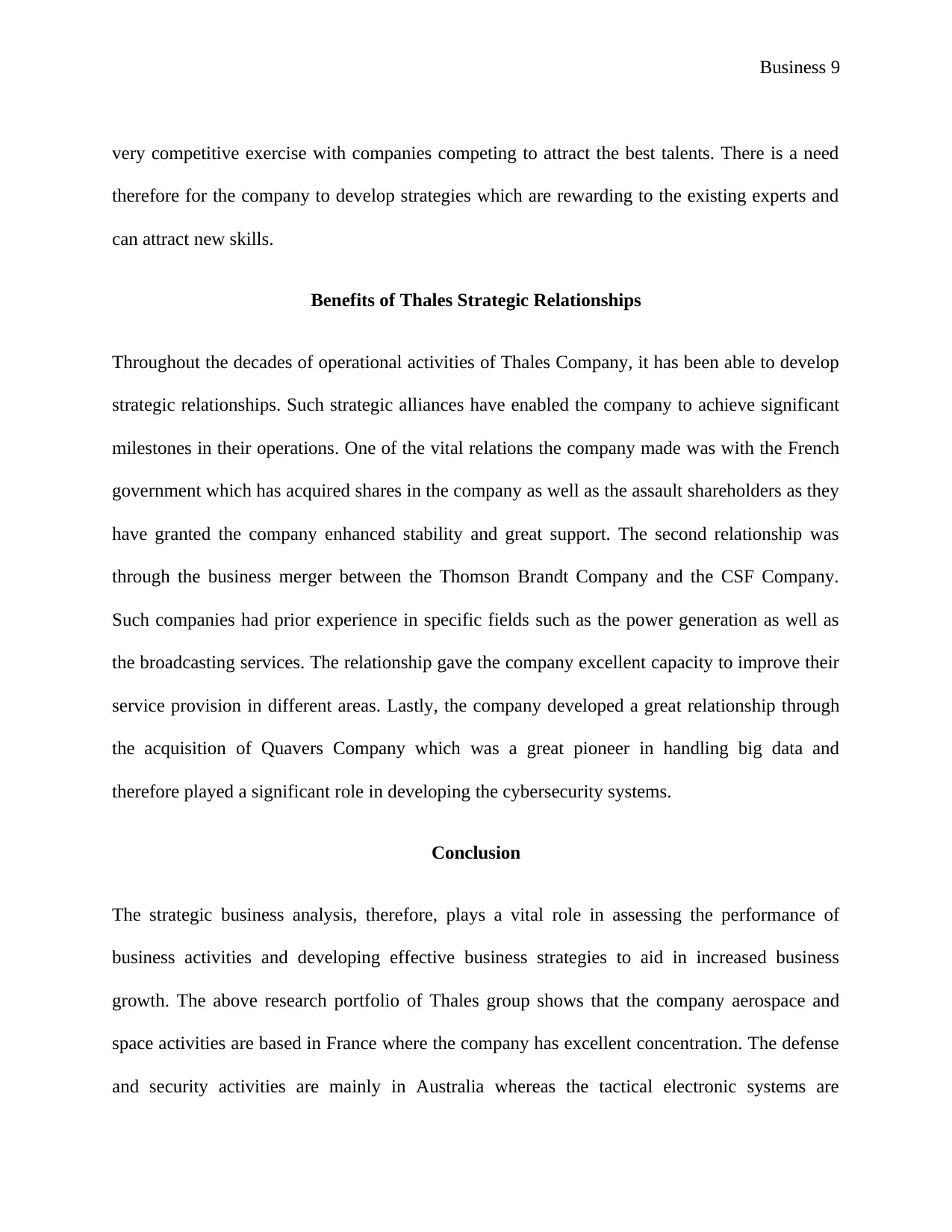
Business 9
very competitive exercise with companies competing to attract the best talents. There is a need
therefore for the company to develop strategies which are rewarding to the existing experts and
can attract new skills.
Benefits of Thales Strategic Relationships
Throughout the decades of operational activities of Thales Company, it has been able to develop
strategic relationships. Such strategic alliances have enabled the company to achieve significant
milestones in their operations. One of the vital relations the company made was with the French
government which has acquired shares in the company as well as the assault shareholders as they
have granted the company enhanced stability and great support. The second relationship was
through the business merger between the Thomson Brandt Company and the CSF Company.
Such companies had prior experience in specific fields such as the power generation as well as
the broadcasting services. The relationship gave the company excellent capacity to improve their
service provision in different areas. Lastly, the company developed a great relationship through
the acquisition of Quavers Company which was a great pioneer in handling big data and
therefore played a significant role in developing the cybersecurity systems.
Conclusion
The strategic business analysis, therefore, plays a vital role in assessing the performance of
business activities and developing effective business strategies to aid in increased business
growth. The above research portfolio of Thales group shows that the company aerospace and
space activities are based in France where the company has excellent concentration. The defense
and security activities are mainly in Australia whereas the tactical electronic systems are
very competitive exercise with companies competing to attract the best talents. There is a need
therefore for the company to develop strategies which are rewarding to the existing experts and
can attract new skills.
Benefits of Thales Strategic Relationships
Throughout the decades of operational activities of Thales Company, it has been able to develop
strategic relationships. Such strategic alliances have enabled the company to achieve significant
milestones in their operations. One of the vital relations the company made was with the French
government which has acquired shares in the company as well as the assault shareholders as they
have granted the company enhanced stability and great support. The second relationship was
through the business merger between the Thomson Brandt Company and the CSF Company.
Such companies had prior experience in specific fields such as the power generation as well as
the broadcasting services. The relationship gave the company excellent capacity to improve their
service provision in different areas. Lastly, the company developed a great relationship through
the acquisition of Quavers Company which was a great pioneer in handling big data and
therefore played a significant role in developing the cybersecurity systems.
Conclusion
The strategic business analysis, therefore, plays a vital role in assessing the performance of
business activities and developing effective business strategies to aid in increased business
growth. The above research portfolio of Thales group shows that the company aerospace and
space activities are based in France where the company has excellent concentration. The defense
and security activities are mainly in Australia whereas the tactical electronic systems are
⊘ This is a preview!⊘
Do you want full access?
Subscribe today to unlock all pages.

Trusted by 1+ million students worldwide
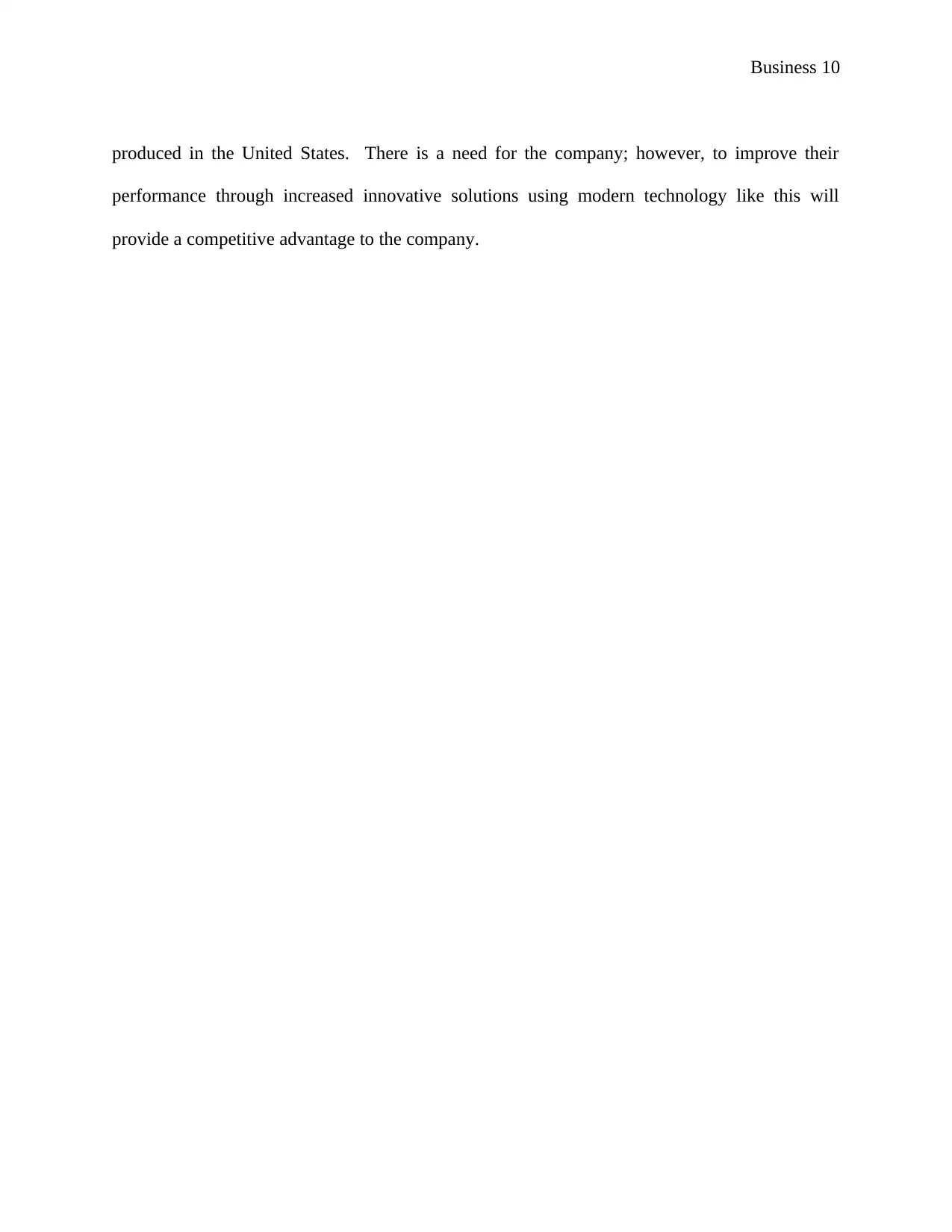
Business 10
produced in the United States. There is a need for the company; however, to improve their
performance through increased innovative solutions using modern technology like this will
provide a competitive advantage to the company.
produced in the United States. There is a need for the company; however, to improve their
performance through increased innovative solutions using modern technology like this will
provide a competitive advantage to the company.
Paraphrase This Document
Need a fresh take? Get an instant paraphrase of this document with our AI Paraphraser
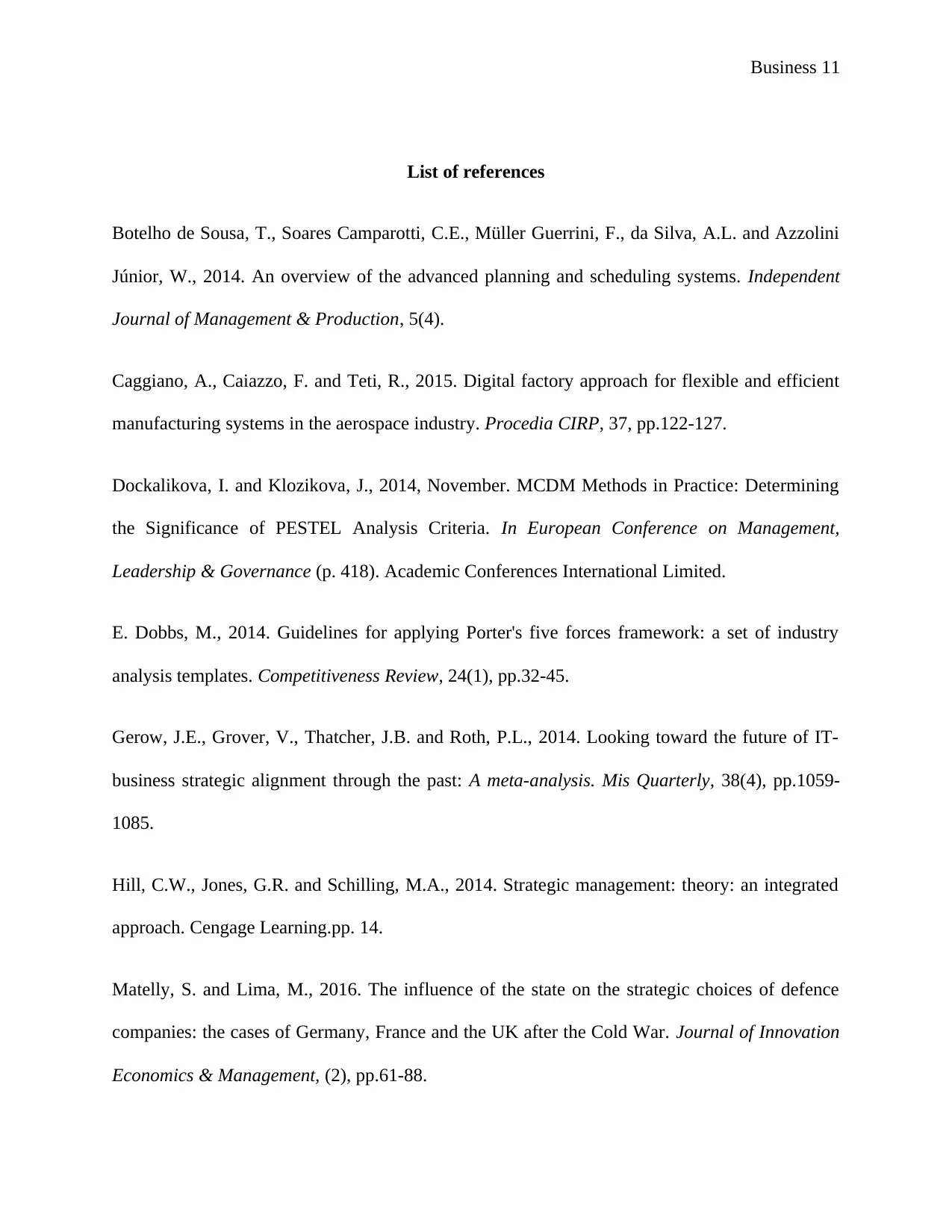
Business 11
List of references
Botelho de Sousa, T., Soares Camparotti, C.E., Müller Guerrini, F., da Silva, A.L. and Azzolini
Júnior, W., 2014. An overview of the advanced planning and scheduling systems. Independent
Journal of Management & Production, 5(4).
Caggiano, A., Caiazzo, F. and Teti, R., 2015. Digital factory approach for flexible and efficient
manufacturing systems in the aerospace industry. Procedia CIRP, 37, pp.122-127.
Dockalikova, I. and Klozikova, J., 2014, November. MCDM Methods in Practice: Determining
the Significance of PESTEL Analysis Criteria. In European Conference on Management,
Leadership & Governance (p. 418). Academic Conferences International Limited.
E. Dobbs, M., 2014. Guidelines for applying Porter's five forces framework: a set of industry
analysis templates. Competitiveness Review, 24(1), pp.32-45.
Gerow, J.E., Grover, V., Thatcher, J.B. and Roth, P.L., 2014. Looking toward the future of IT-
business strategic alignment through the past: A meta-analysis. Mis Quarterly, 38(4), pp.1059-
1085.
Hill, C.W., Jones, G.R. and Schilling, M.A., 2014. Strategic management: theory: an integrated
approach. Cengage Learning.pp. 14.
Matelly, S. and Lima, M., 2016. The influence of the state on the strategic choices of defence
companies: the cases of Germany, France and the UK after the Cold War. Journal of Innovation
Economics & Management, (2), pp.61-88.
List of references
Botelho de Sousa, T., Soares Camparotti, C.E., Müller Guerrini, F., da Silva, A.L. and Azzolini
Júnior, W., 2014. An overview of the advanced planning and scheduling systems. Independent
Journal of Management & Production, 5(4).
Caggiano, A., Caiazzo, F. and Teti, R., 2015. Digital factory approach for flexible and efficient
manufacturing systems in the aerospace industry. Procedia CIRP, 37, pp.122-127.
Dockalikova, I. and Klozikova, J., 2014, November. MCDM Methods in Practice: Determining
the Significance of PESTEL Analysis Criteria. In European Conference on Management,
Leadership & Governance (p. 418). Academic Conferences International Limited.
E. Dobbs, M., 2014. Guidelines for applying Porter's five forces framework: a set of industry
analysis templates. Competitiveness Review, 24(1), pp.32-45.
Gerow, J.E., Grover, V., Thatcher, J.B. and Roth, P.L., 2014. Looking toward the future of IT-
business strategic alignment through the past: A meta-analysis. Mis Quarterly, 38(4), pp.1059-
1085.
Hill, C.W., Jones, G.R. and Schilling, M.A., 2014. Strategic management: theory: an integrated
approach. Cengage Learning.pp. 14.
Matelly, S. and Lima, M., 2016. The influence of the state on the strategic choices of defence
companies: the cases of Germany, France and the UK after the Cold War. Journal of Innovation
Economics & Management, (2), pp.61-88.
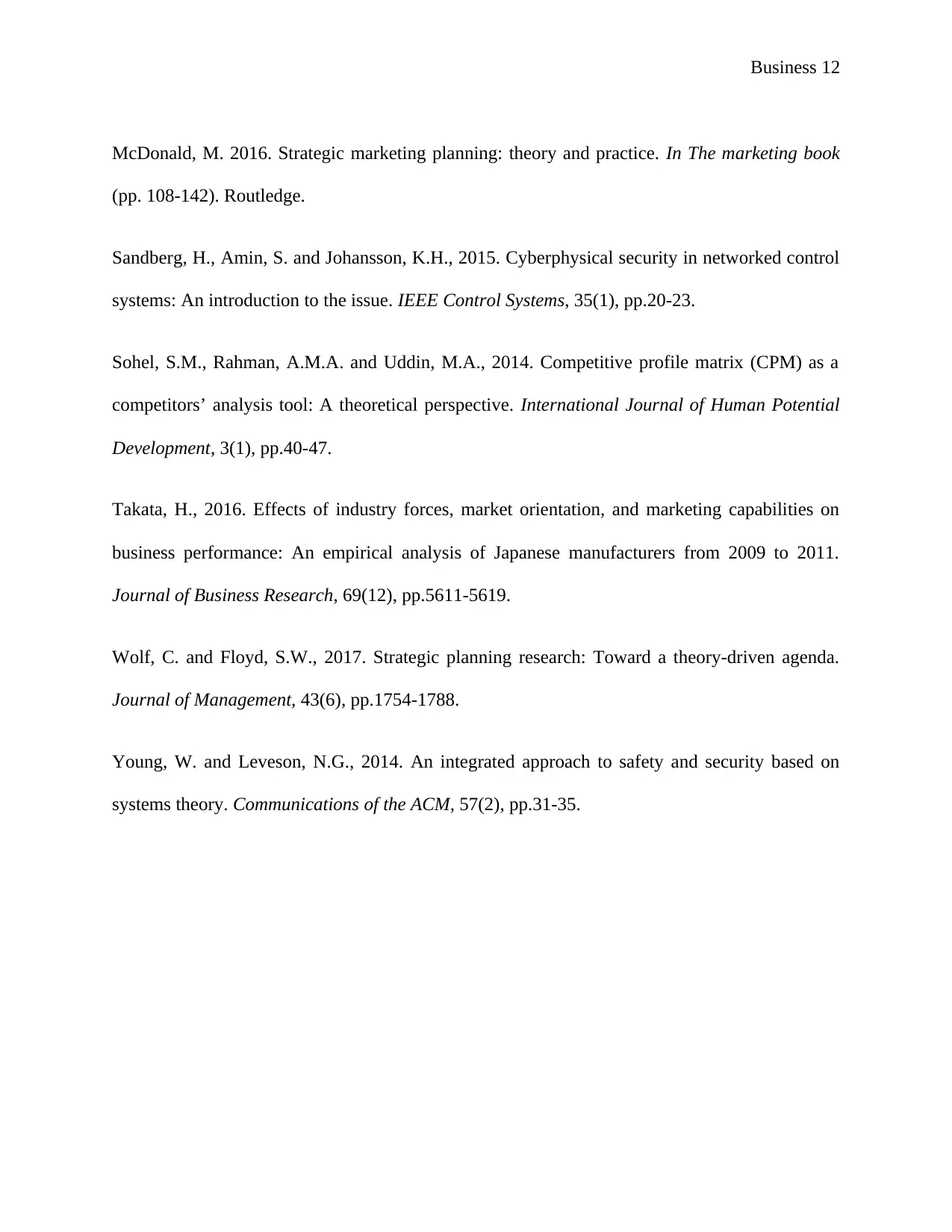
Business 12
McDonald, M. 2016. Strategic marketing planning: theory and practice. In The marketing book
(pp. 108-142). Routledge.
Sandberg, H., Amin, S. and Johansson, K.H., 2015. Cyberphysical security in networked control
systems: An introduction to the issue. IEEE Control Systems, 35(1), pp.20-23.
Sohel, S.M., Rahman, A.M.A. and Uddin, M.A., 2014. Competitive profile matrix (CPM) as a
competitors’ analysis tool: A theoretical perspective. International Journal of Human Potential
Development, 3(1), pp.40-47.
Takata, H., 2016. Effects of industry forces, market orientation, and marketing capabilities on
business performance: An empirical analysis of Japanese manufacturers from 2009 to 2011.
Journal of Business Research, 69(12), pp.5611-5619.
Wolf, C. and Floyd, S.W., 2017. Strategic planning research: Toward a theory-driven agenda.
Journal of Management, 43(6), pp.1754-1788.
Young, W. and Leveson, N.G., 2014. An integrated approach to safety and security based on
systems theory. Communications of the ACM, 57(2), pp.31-35.
McDonald, M. 2016. Strategic marketing planning: theory and practice. In The marketing book
(pp. 108-142). Routledge.
Sandberg, H., Amin, S. and Johansson, K.H., 2015. Cyberphysical security in networked control
systems: An introduction to the issue. IEEE Control Systems, 35(1), pp.20-23.
Sohel, S.M., Rahman, A.M.A. and Uddin, M.A., 2014. Competitive profile matrix (CPM) as a
competitors’ analysis tool: A theoretical perspective. International Journal of Human Potential
Development, 3(1), pp.40-47.
Takata, H., 2016. Effects of industry forces, market orientation, and marketing capabilities on
business performance: An empirical analysis of Japanese manufacturers from 2009 to 2011.
Journal of Business Research, 69(12), pp.5611-5619.
Wolf, C. and Floyd, S.W., 2017. Strategic planning research: Toward a theory-driven agenda.
Journal of Management, 43(6), pp.1754-1788.
Young, W. and Leveson, N.G., 2014. An integrated approach to safety and security based on
systems theory. Communications of the ACM, 57(2), pp.31-35.
⊘ This is a preview!⊘
Do you want full access?
Subscribe today to unlock all pages.

Trusted by 1+ million students worldwide
1 out of 12
Related Documents
Your All-in-One AI-Powered Toolkit for Academic Success.
+13062052269
info@desklib.com
Available 24*7 on WhatsApp / Email
![[object Object]](/_next/static/media/star-bottom.7253800d.svg)
Unlock your academic potential
Copyright © 2020–2025 A2Z Services. All Rights Reserved. Developed and managed by ZUCOL.





